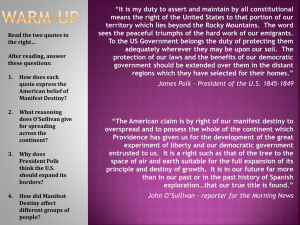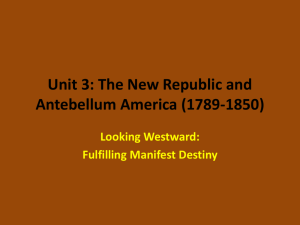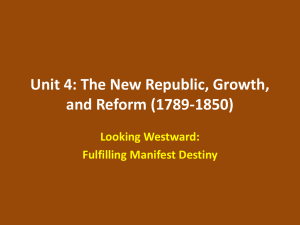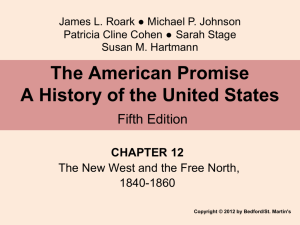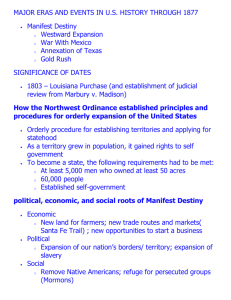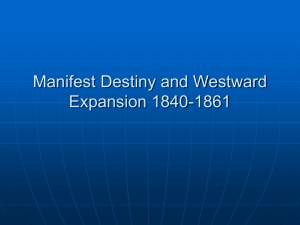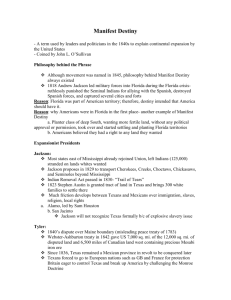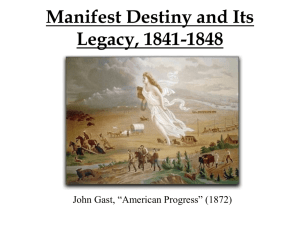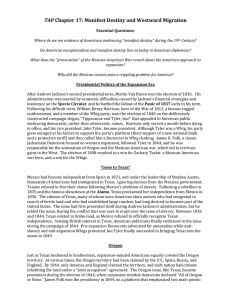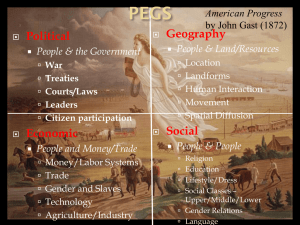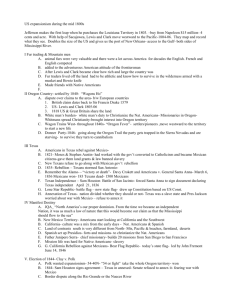Chapter13 Manifest Destiny 1825-1854
advertisement
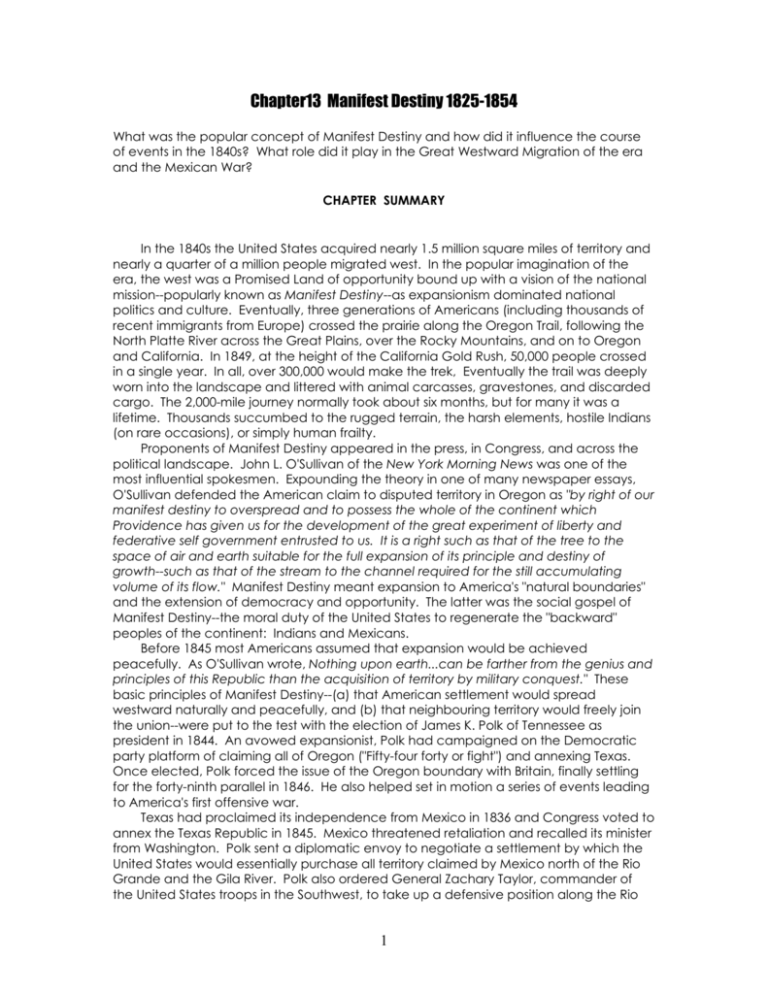
Chapter13 Manifest Destiny 1825-1854 What was the popular concept of Manifest Destiny and how did it influence the course of events in the 1840s? What role did it play in the Great Westward Migration of the era and the Mexican War? CHAPTER SUMMARY In the 1840s the United States acquired nearly 1.5 million square miles of territory and nearly a quarter of a million people migrated west. In the popular imagination of the era, the west was a Promised Land of opportunity bound up with a vision of the national mission--popularly known as Manifest Destiny--as expansionism dominated national politics and culture. Eventually, three generations of Americans (including thousands of recent immigrants from Europe) crossed the prairie along the Oregon Trail, following the North Platte River across the Great Plains, over the Rocky Mountains, and on to Oregon and California. In 1849, at the height of the California Gold Rush, 50,000 people crossed in a single year. In all, over 300,000 would make the trek, Eventually the trail was deeply worn into the landscape and littered with animal carcasses, gravestones, and discarded cargo. The 2,000-mile journey normally took about six months, but for many it was a lifetime. Thousands succumbed to the rugged terrain, the harsh elements, hostile Indians (on rare occasions), or simply human frailty. Proponents of Manifest Destiny appeared in the press, in Congress, and across the political landscape. John L. O'Sullivan of the New York Morning News was one of the most influential spokesmen. Expounding the theory in one of many newspaper essays, O'Sullivan defended the American claim to disputed territory in Oregon as "by right of our manifest destiny to overspread and to possess the whole of the continent which Providence has given us for the development of the great experiment of liberty and federative self government entrusted to us. It is a right such as that of the tree to the space of air and earth suitable for the full expansion of its principle and destiny of growth--such as that of the stream to the channel required for the still accumulating volume of its flow." Manifest Destiny meant expansion to America's "natural boundaries" and the extension of democracy and opportunity. The latter was the social gospel of Manifest Destiny--the moral duty of the United States to regenerate the "backward" peoples of the continent: Indians and Mexicans. Before 1845 most Americans assumed that expansion would be achieved peacefully. As O'Sullivan wrote, Nothing upon earth...can be farther from the genius and principles of this Republic than the acquisition of territory by military conquest." These basic principles of Manifest Destiny--(a) that American settlement would spread westward naturally and peacefully, and (b) that neighbouring territory would freely join the union--were put to the test with the election of James K. Polk of Tennessee as president in 1844. An avowed expansionist, Polk had campaigned on the Democratic party platform of claiming all of Oregon ("Fifty-four forty or fight") and annexing Texas. Once elected, Polk forced the issue of the Oregon boundary with Britain, finally settling for the forty-ninth parallel in 1846. He also helped set in motion a series of events leading to America's first offensive war. Texas had proclaimed its independence from Mexico in 1836 and Congress voted to annex the Texas Republic in 1845. Mexico threatened retaliation and recalled its minister from Washington. Polk sent a diplomatic envoy to negotiate a settlement by which the United States would essentially purchase all territory claimed by Mexico north of the Rio Grande and the Gila River. Polk also ordered General Zachary Taylor, commander of the United States troops in the Southwest, to take up a defensive position along the Rio 1 Grande and prepare for "appropriate action" should hostilities occur. The Mexican government rebuffed Polk's envoy and Mexican troops crossed the river and attacked a small squadron of Taylor's forces. War was officially declared two weeks later, as soon as news of the attack reached Washington. In eighteen hectic months, the United States won an unbroken string of military victories, eventually occupying California, New Mexico, and Mexico City. In the Treaty of Guadalupe Hidalgo (1848), the United States acquired all territories formerly held by the Mexican government, including Texas north of the Rio Grande, New Mexico (including present-day Arizona), Utah (including presentday Nevada), and California, all for $15 million. Annexation of Texas in 1845 was the "spark that touched off the explosion" but American expansion under the doctrine of Manifest Destiny was the real cause of the Mexican War. Approximate Date and Event 1821 Mexico gains independence from Spain; Stephen F. Austin leads American settlers into Texas 1830 Mexican government tries to restrict immigration into Texas 1835 Mexican effort to suppress Texas independence leads to the Battle of the Alamo 1836 Texas Republic established after defeat of Santa Anna at the San Jacinto River; Sam Houston (former governor of Tennessee) chosen president of the Republic of Texas 1841 President Harrison dies shortly after inauguration; John Tyler becomes president-tries to negotiate annexation of Texas 1844 Mass migration to Oregon; James K. Polk elected president ("Fifty-four Forty or Fight") 1845 Annexation of Texas into the Union; phrase "Manifest Destiny" popularized 1846 War with Mexico declared; Oregon treaty settles boundary dispute with British 1848 War with Mexico concluded; Taylor elected president; Gold discovered in California 1850 California admitted into the Union 2
